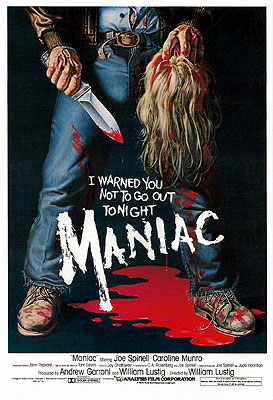 Maniac (1980) ****
Maniac (1980) ****
It is my experience that a good way to predict the quality of a 70’s or 80’s slasher film is to count the number of people who publicly object to it on moral grounds. The more enemies one of these films has, the better it usually is. Nobody ever complains about the evil tendencies of pieces of shit like Eyeball or The Prey, but the bluenoses came crawling out of the woodwork to protest when The Texas Chainsaw Massacre and Don’t Go in the House came out. William Lustig’s early masterwork, Maniac, enjoys the same rarefied distinction as the latter-named film— even many horror fans treat it like a leprous street person. Hell, Tom Savini of all people felt so sullied by his involvement in Maniac’s creation that he asked that his name be removed from the credits! With a history like that, you know it’s got to be good.
At the same time, it’s easy to see why so many people find it sickening and grotesque— it is. Maniac concerns a certain Frank Zito (Joe Spinell, from Starcrash and The Last Horror Film, who also wrote and produced Maniac), a man very much like Norman Bates as Robert Bloch originally wrote him. Zito is overweight, unattractive, and a bad dresser, with poor social skills and a broad catalogue of off-putting mannerisms. And like Bloch’s Bates, he’s also a mother-fixated serial killer who likes to keep souvenirs of his crimes. Specifically, Zito scalps and strips his victims after committing his murders, using their clothes and hair to dress the large collection of mannequins he keeps in his claustrophobic New York apartment. He also appears to have a slight fracture to his personality, for he often has conversations with himself as he sits alone in his room.
Maniac has few other characters and almost no plot worthy of the name. What little story there is (look for it wedged in between the unconnected murders) revolves around Zito’s brief and rather implausible affair with a beautiful photographer named Anna (Caroline Munro, who had an almost invisible role as the doctor’s embalmed wife in The Abominable Dr. Phibes and Dr. Phibes Rises Again), whom he meets one day while she’s taking pictures in a park. Anna introduces Zito to her friend, Rita (Gail Lawrence, better known as porn queen Abigail Clayton), a model with whom she frequently collaborates. You don’t have to be an Isaac Newton or a Max Planck to figure out that some very bad things are headed Anna and Rita’s way as a result of their involvement with Zito, and you don’t have to be such a thinker to guess what form those very bad things are going to take, either.
But this movie isn’t really much concerned with the story per se. Like the later Henry: Portrait of a Serial Killer, it is mainly a character study, and also like Henry, the character it studies is one fucked up son of a bitch. This is the primary root of all the complaints regarding Maniac, the fact that it spends its entire running time inside Zito’s head, and that it relates to its other characters only the way Zito does— as prey. The frequent accusations of misogyny are thus understandable, though I would argue that they are also short-sighted and simplistic. It is a fallacy (though a commonly encountered one) to assume that a film that puts its (presumed male) audience into the mind of a pathological killer puts that audience someplace they actually want to be. Lustig himself once told an interviewer from Fangoria that the scariest thing about Maniac is the fact that men like Frank Zito really exist. His statement hints at something most critics miss completely— that the horror of Maniac derives from the very fact that it forces you to experience the world as Zito does. Though it is incredibly, shockingly violent even 20 years after its release, it is absolutely not a sadistic movie, in that the film maintains at all times a curious, clinical detachment from the violence. The camera watches Zito’s crimes with an unblinking, unflinching gaze, but it never leers as it does in so many other horror films. Only the most unsophisticated viewer could interpret Maniac’s frankly squalid tone as glorifying or romanticizing the murders that Zito commits. Rather than drooling over the killings, as most commentators seem to assume the film’s few fans to be doing, the viewer is far more likely to sigh with relief as the credits roll, left with the feeling that they’ve just spent most of an hour and a half banging on the inside of Zito’s skull, screaming, “Let me out of here, goddamnit! Let me the fuck out!!!!” It’s not the sort of thing one wants to experience often, but there’s definitely something to be said for doing it every once in a while. Assuming, that is, you have the nerve to handle it.
Home Alphabetical Index Chronological Index Contact

